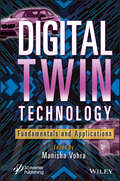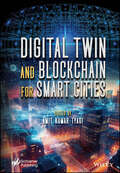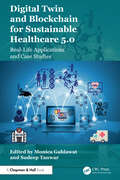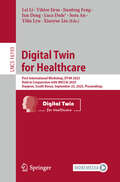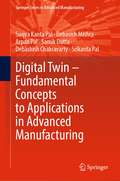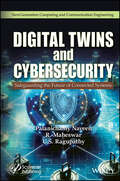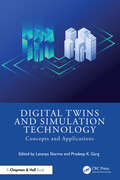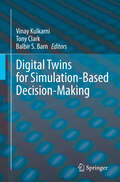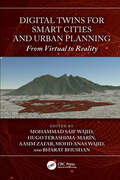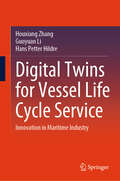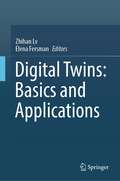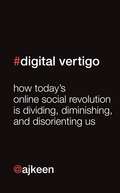- Table View
- List View
Digital Twin Technology: Fundamentals and Applications
by Manisha VohraDIGITAL TWIN TECHNOLOGY The book lucidly explains the fundamentals of digital twin technology along with its applications and various industrial real-world examples. Digital twin basically means a replicated model of any object or product in digital form. A digital twin has many advantages as it remains connected with the original object or product it is replicating and receives real-time data. Therefore, the obstacles and issues that could be encountered in a product or object can be known before their actual happening which helps to prevent errors and major losses which otherwise might have been incurred. The various capabilities of digital twin technology make it a powerful tool that can be used to effectively boost various sectors of the healthcare, automotive, and construction industries, among others. Although this technology has been making its way into various sectors, it has not yet received the kind of exposure necessary to increase awareness of its potential in these industries. Therefore, it is critical that a better understanding of digital twin technology is acquired to facilitate growth and to have it implemented in the various sectors so that transformation can be ushered in. Therefore, this book was designed to be a useful resource for those who want to become well acquainted with digital twin technology. Audience Engineers, researchers, and advanced students in information technology, computer science, and electronics, as well as IT specialists and professionals in various industries such as healthcare, automotive, and transportation.
Digital Twin and Blockchain for Smart Cities
by Amit Kumar TyagiThe book uniquely explores the fundamentals of blockchain and digital twin technologies and their uses in smart cities. In the previous decade, many governments explored artificial intelligence, digital twin, and blockchain, and their roles in smart cities. This book discusses the convergence of two transformative technologies, digital twin and blockchain, to address urban challenges and propel the development of smarter, more sustainable cities. This convergence empowers cities to create real-time replicas of urban environments (digital twins) and secure, transparent data management (blockchain) to improve city planning, management, and civic services. In this application, the concept of a digital twin involves creating a virtual, data-driven replica of a city or specific urban systems, such as transportation, energy, or infrastructure. This digital twin mirrors the real world, gathering data from various sensors, IoT devices, and other sources to provide a holistic view of the city’s operations. Furthermore, blockchain technology offers a decentralized and tamper-resistant ledger for securely storing and managing data. In the context of smart cities, blockchain can ensure data integrity, privacy, and transparency, enabling trust and collaboration among various stakeholders. This book covers many important topics, including real-time city modeling; data security and the trustworthy storage of sensitive urban data; transparent governance to facilitate accountable governance and decision-making processes in smart cities; improved city services; disaster resilience (by providing insights into vulnerabilities and efficient resource allocation during crises); sustainable urban planning that optimizes resource allocation, reduces energy consumption, and minimizes environmental impact, which fosters sustainable development; citizen engagement; and much more. This book will not only provide information about more efficient, resilient, and sustainable urban environments, but it also empowers citizens to be active participants in shaping the future of their cities. By converging these technologies, cities can overcome existing challenges, encourage innovation, and create more livable, connected, and responsive urban spaces. Audience This book has a wide audience in computer science, artificial intelligence, and information technology as well as engineers in a variety of industrial manufacturing industries. It will also appeal to economists and government/city policymakers working on smart cities, the circular economy, clean tech investors, urban decision-makers, and environmental professionals.
Digital Twin and Blockchain for Sustainable Healthcare 5.0: Real-Life Applications and Case Studies
by Monica Gahlawat and Sudeep TanwarThis book investigates blockchain and digital twin technologies to offer insights into their potential applications in the healthcare industry. It explores how these technologies can work together to build a strong and sustainable healthcare ecosystem, improve patient satisfaction, and streamline administrative procedures. Through examples, case studies and discussions, the book highlights their use in supply chain management, disease prediction, and patient monitoring. It addresses challenges and offers solutions, examining ethical and legal considerations and the integration of patient preferences.• Explores how blockchain technology can support digital twin technology in healthcare applications, facilitating efficient and secure data management. • Studies utilisation of advanced machine learning algorithms and predictive models in healthcare applications.• Discusses how the integration of digital twin and blockchain technologies can contribute to sustainable development in personalised healthcare. • Considers the ethical and legal implications associated with personalised treatment options, providing a comprehensive examination of these considerations. • Integration of patient preferences into personalised healthcare approaches, emphasising the importance of patient-centric care. Aimed at professionals, researchers, and policymakers interested in Healthcare 5.0., the book provides comprehensive coverage of these technologies and their role in shaping sustainable healthcare practices.
Digital Twin for Healthcare: First International Workshop, DT4H 2025, Held in Conjunction with MICCAI 2025, Daejeon, South Korea, September 23, 2025, Proceedings (Lecture Notes in Computer Science #16193)
by Jianfeng Feng Jun Deng Lei Li Viktor Jirsa Luca Dede’ Sora An Yilin Lyu Xiaoyue LiuThis book, LNCS 16193, constitutes the proceedings of the First International Workshop on Digital Twin for Healthcare, DT4H 2025, held in conjunction with MICCAI 2025, in Daejeon, South Korea, during September 23, 2025. The 15 full papers included in the book were carefully reviewed and selected from 24 submissions. They deal with integrating Digital Twin frameworks with conventional medical imaging and computational tools, focusing on topics such as organ- and disease-specific DT modeling; multi-modal data integration; AI-driven simulation and prediction; DT-guided diagnostic and treatment planning; etc.
Digital Twin – Fundamental Concepts to Applications in Advanced Manufacturing (Springer Series in Advanced Manufacturing)
by Surjya Kanta Pal Debasish Mishra Arpan Pal Samik Dutta Debashish Chakravarty Srikanta PalThis book provides readers with a guide to the use of Digital Twin in manufacturing. It presents a collection of fundamental ideas about sensor electronics and data acquisition, signal and image processing techniques, seamless data communications, artificial intelligence and machine learning for decision making, and explains their necessity for the practical application of Digital Twin in Industry.Providing case studies relevant to the manufacturing processes, systems, and sub-systems, this book is beneficial for both academics and industry professionals within the field of Industry 4.0 and digital manufacturing.
Digital Twin: A Dynamic System and Computing Perspective
by Ranjan Ganguli Sondipon Adhikari Souvik Chakraborty Mrittika GanguliThe digital twin of a physical system is an adaptive computer analog which exists in the cloud and adapts to changes in the physical system dynamically. This book introduces the computing, mathematical, and engineering background to understand and develop the concept of the digital twin. It provides background in modeling/simulation, computing technology, sensor/actuators, and so forth, needed to develop the next generation of digital twins. Concepts on cloud computing, big data, IoT, wireless communications, high-performance computing, and blockchain are also discussed. Features: Provides background material needed to understand digital twin technology Presents computational facet of digital twin Includes physics-based and surrogate model representations Addresses the problem of uncertainty in measurements and modeling Discusses practical case studies of implementation of digital twins, addressing additive manufacturing, server farms, predictive maintenance, and smart cities This book is aimed at graduate students and researchers in Electrical, Mechanical, Computer, and Production Engineering.
Digital Twin: Fundamentals and Applications
by Newton Lee Soheil Sabri Kostas AlexandridisDigital twin technologies, currently at the forefront of development, play a crucial role in integrated systems, industrial design, manufacturing, data analytics, and decision-making processes. As we move forward, digital twin technologies, along with their enabling technologies such as Artificial Intelligence, Machine Learning, Internet of Things (IoT), metaverse, and advanced visualization features, will continue to drive digital transformation and innovation across various societal contexts. This book presents a conceptual framework that examines critical perspectives on digital twins across diverse disciplines. It evaluates the contributions of leading thinkers to the broader discourse about digital twins. The introductory chapter provides an overview of the entire book, summarizing all subsequent chapters. Chapter 2 delves into the fundamentals of digital twins, covering theories, definitions, and enabling technologies. Chapters 3 to 10 explore various application areas, including smart cities, manufacturing, healthcare, infrastructure, and supply chain. Chapter 10 specifically focuses on socio-technical aspects related to the design, development, and implementation of digital twins. It emphasizes the significance of digital twins as a public good and identifies opportunities, gaps, and challenges. The final chapter addresses the current and future need for skills in training, education, and awareness, proposing collaborative approaches for industry and academia.
Digital Twins and Cybersecurity: Safeguarding the Future of Connected Systems
by R. Maheswar Palanichamy Naveen U. S. RagupathyThis book serves as a comprehensive guide to understanding the complex relationship between digital twins and cybersecurity, providing practical strategies for safeguarding connected systems. This book explores the convergence of digital twins and cybersecurity, offering insights, strategies, and best practices for safeguarding connected systems. It examines the definition, evolution, types, and applications of digital twins across industries like manufacturing, healthcare, and transportation. Highlighting growing digital threats, it underscores the need for robust cybersecurity measures to protect the integrity and confidentiality of digital twin ecosystems. The book analyzes key components and infrastructure of digital twins, including data flow, communication channels, vulnerabilities, and security considerations. It also addresses privacy challenges and explores relevant regulations and compliance requirements. Guiding readers through implementing security measures, it presents a comprehensive cybersecurity framework, covering data protection, encryption, and strategies for ensuring data integrity and confidentiality. It also explores incident response and recovery, secure communication protocols, and the roles of gateways and firewalls. Industry-specific challenges and mitigation strategies are examined through real-world case studies, offering valuable insights and lessons learned. Emerging trends in digital twin technology are thoroughly explored, including the impact of advancements such as AI and quantum computing and their associated cybersecurity challenges and solutions. Audience This book is an essential resource for professionals in the fields of cybersecurity and industrial and infrastructure sectors, including manufacturing, healthcare, transportation, and other industries that utilize digital twins. Researchers in computer science, cybersecurity, engineering, and technology, as well as policymakers and regulatory bodies, will also find this book highly useful.
Digital Twins and ESG
by Adesh Kumar Surajit Mondal Mudassir KhanDigital Twins and ESG provides essential insight on how integrating cutting-edge Digital Twin technology with ESG practices can transform the understanding of sustainability and propel businesses towards a more transparent, accountable, and responsible future. Digital Twins and ESG introduces the dynamic world of ESG practices, emphasizing the pivotal role technology plays in shaping and advancing sustainability goals. It introduces readers to the multifaceted world of Digital Twin technology, offering a comprehensive understanding of its historical development and diverse applications across industries. This volume will intricately examine the integration of Digital Twins in ESG metrics and reporting frameworks. Artificial intelligence, machine learning, and blockchain technologies are also discussed as key enablers for achieving ESG goals, providing readers with a glimpse into the potential advancements and breakthroughs that lie ahead. Through detailed analyses and case studies, readers will gain insights into how Digital Twins enhance data collection, monitoring, and reporting, elevating transparency and accountability. Digital Twins and ESG serves as a rallying call, urging businesses to embrace Digital Twins as an integral component of their ESG strategies, ultimately paving the way for a more sustainable and responsible future.
Digital Twins and Simulation Technology: Concepts and Applications
by Lavanya Sharma and Pradeep K. GargThis book provides a comprehensive overview of the concept of digital twins, emphasising its strategic importance across various commercial domains. This book covers the fundamentals, data requirements, tools, and technologies essential for understanding and implementing digital twins. It discusses how digital twins are used for running simulations, analysing performance issues, and generating potential improvements to optimise business processes. The book explores the architecture, historical background, and real-time applications in sectors including urban planning, healthcare, smart cities, and manufacturing. Explains digital twin technology, including its core principles, architecture, and how it replicates physical objects in virtual platforms, in detail Covers the data types and tools necessary for creating and maintaining digital twins, including sensors, data processing systems, and integration methodologies Explores technologies such as Computer Vision, IoT, AI, ML, 5G, AR, and VR that drive the functionality and application of digital twins Analyses practical applications in diverse sectors like urban planning, smart cities, healthcare, manufacturing operations, and power-generation equipment, showcasing real-world use cases and benefits Examines real-time challenges and limitations associated with implementing digital twin technology, providing a balanced view of its capabilities and constraints It is a reference book for researchers, scholars, and students who are working or interested in learning about digital twin technology.
Digital Twins for Digital Transformation: Innovation in Industry (Studies in Systems, Decision and Control #423)
by Ashraf Darwish Vaclav Snasel Aboul Ella HassanienThis book aims to present dominant applications and use cases of the fast-evolving DT and determines vital Industry 4.0 technologies for building DT that can provide solutions for fighting local and globalmedical emergencies during pandemics. Moreover, it discusses a new framework integrating DT and blockchain technology to provide a more efficient and effective preventive conservation in different applications.
Digital Twins for Simulation-Based Decision-Making
by Tony Clark Balbir S. Barn Vinay KulkarniThis book introduces the concept of digital twins and their purposive usage, including the technology infrastructure and the method support necessary for their construction. The landscape of digital twins is illustrated through a range of use cases spread across different application domains such as strategy and business assessment in enterprises, logistics networks, manufacturing industries, chemical and refinery systems, sustainable food ecosystems, and public healthcare. All these examples show how digital twins are exploited to simulate complex scenarios depending on various external factors – all of which would not be feasible as real-world simulations because of their high costs, potential fatal damages, and unpredictable side effects. The book is written for professionals in industry who would like to learn about the application of these powerful methodologies and tools in various areas as well as for researchers in computer science who would like to draw inspirations for further development of this technology from real-world applications.
Digital Twins for Smart Cities and Urban Planning: From Virtual to Reality
by Bharat Bhushan Mohd Anas Wajid Aasim Zafar Mohammad Saif Wajid Hugo Terashima-MarínThis book discusses the concept of the digital twin, which has the potential to change how systems are managed and created. It also discusses the metaverse as a new technology with literary roots, cross-platform avatars, and artificial intelligence-related cybersecurity risks.Digital Twin for Smart Cities and Urban Planning: From Virtual to Reality provides practitioners with concrete problem-solving methodologies while covering the most recent and cutting-edge digital twin application technologies in diverse fields. It highlights the benefits of digital twins in terms of data visualization, real-time data analytics, and learning, which leads to increased confidence in decision-making. The book discusses the metaverse as a new technology with literary roots, cross-platform avatars, and artificial intelligence-related cybersecurity risks. It also evaluates the opportunities that DT can provide for smart cities and discusses the prerequisites for secure, safe, and sustainable smart cities. It also explores the mix between the industrial Internet of Things, artificial intelligence, machine learning, and software analytics with spatial network graphs to construct living digital simulation models that update and alter in response to changes in their physical counterparts. The chapters also focus on digital twin driven smart design which establishes a foundation for the adoption of digital twin technology in product design by drawing on the most recent industry practice and research.The book is an excellent resource for practitioners and scholars in manufacturing, operations research, and communications who are thinking about digitizing their assets and related services. It is also a helpful resource for graduate students and academics looking to better understand pioneering digital twins technologies.
Digital Twins for Vessel Life Cycle Service: Innovation in Maritime Industry
by Guoyuan Li Houxiang Zhang Hans Petter HildreThis book introduces the development of the digital twin of the marine infrastructure in Norway, which will be a significant scientific and operational achievement for the industry, making efficient and safe offshore operations possible. It enables data exchange safely and easily between different sub-systems, modules, and various applications. A complete digital twin ship will be presented in details. Thus, the twin ship can provide an integrated view of the ship’s various physical and behavioral aspects in different stages, and allow simultaneous optimization of functional performance requirements. In addition, it enables advanced control and optimization, e.g., creating more reliable prediction for flexible objectives (time, output, emissions, fuel consumption), and executing day-ahead and long-term planning for operations. More importantly, several related applications and case studies are presented in the end to confirm the effectiveness of the digital twin system. The research work is not only interesting for academia, also for industry.
Digital Twins for Wireless Networks: Overview, Architecture, and Challenges
by Waleed Ejaz Muhammad Khalil Afzal Muhammad NaeemThe sixth-generation (6G) communication systems are anticipated to provide network connectivity for an extensive range of use cases in a variety of emerging vertical industries. Consequently, a new set of challenging requirements and more stringent key performance indicators have to be considered, a novel architecture has to be designed, and unique enabling technologies shall be developed in order to fulfil the technical, regulatory, and business demands of the communication service customers. 6G networks are expected to offer even faster speeds, lower latency, and greater capacity compared to 5G networks, which will enable new applications and use cases that are currently not possible. Improved quality of life by enabling various applications (emerging Internet of everything applications) such as healthcare, brain-computer interactions, and extended reality is the main focus of future wireless services. Quality of experience, latency, and reliability are the key requirements of these applications. To meet these diverse requirements there is a need to assist wireless systems with unique technologies. Self-sustaining wireless systems (intelligence, seamless and ubiquitous connectivity) and proactive-online-learning-enables systems (Intelligent analytics) are two trends in future wireless systems. The digital twin technology is one of the most promising technologies that can be instrumental in realizing the technical and business objectives of 6G communication systems. A digital twin is a virtual imitation of a physical object or system. In a wireless system, a digital twin can be used to model and analyse the behaviour of the network and its components, such as antennas, transmitters, receivers, sensors, and other devices in wireless networks. One of the key benefits of using a digital twin for a wireless system is that it can help network operators and engineers to optimize the performance of the wireless network by simulating different scenarios and configurations. Other benefits include improve efficiency, cost saving, and enhanced security. In 6G networks, a digital twin could be used to simulate and optimize the performance. This could include simulating different network topologies, testing the performance of different network protocols and algorithms, and optimizing the placement of network infrastructure. To create a digital twin of a wireless network, a detailed model of the network and its components must be developed, based on real-world data and conditions. This model can then be used to simulate the behaviour of the network under different conditions and settings and to visualize the results in real time.
Digital Twins in Industrial Production and Smart Manufacturing: An Understanding of Principles, Enhancers, and Obstacles
by Seifedine Kadry Balamurugan Balusamy Ali Kashif Bashir Rajesh Kumar Dhanaraj Prithi SamuelComprehensive reference exploring the benefits and implementation of digital twins in industrial production and manufacturing Digital Twins in Industrial Production and Smart Manufacturing provides an overview of digital twin theoretical concepts, techniques, and recent trends used to meet the requirements and challenges of industrial production and smart manufacturing. The text describes how to achieve industrial excellence through virtual factory simulation and digital modeling innovations for next-generation manufacturing system design. The contributing authors address the many possible technical advantages of major Industry 5.0 technological advancements, using illustrations to aid readers in practical implementation of concepts, along with existing scenarios, potential research gaps, adoption difficulties, case studies, and future research objectives. The text also presents many applications and use cases of Industry 5.0 and digital twins in a variety of industries, including the aerospace industry, pharmaceutical manufacturing and biotech, augmented reality, virtual reality, edge computing and blockchain-based Internet of Things (IoT), cobots, intelligent logistics and supply chain management, and more. Edited by a group of highly qualified academics with significant experience in the field, Digital Twins in Industrial Production and Smart Manufacturing covers additional topics such as: Hyper-automation technology, including specialized workflow procedures and particular sectors of solicitations linked to hyper-automationDigital twins in the context of smart cities, with attempts to draw comparisons with the use of digital twins in industrial IoTVirtual factories based on digital twins and corresponding architecture to facilitate modeling, simulation, and assessment of manufacturing systemsCognitive, interactive, and standardization aspects of digital twins, and the proper implementation of digital twin technology for safety critical systems Digital Twins in Industrial Production and Smart Manufacturing is a must-have reference for researchers, scholars, and professionals in fields related to digital twins in industrial production and manufacturing. It is also suitable as a hands-on resource for students interested in the fields of digital twins and smart manufacturing.
Digital Twins in Manufacturing: Virtual and Physical Twins for Advanced Manufacturing (Springer Series in Advanced Manufacturing)
by Vytautas OstaševičiusThis book presents a guide to digital twin technologies and their applications within manufacturing. It examines key technological advances in the area of Industry 4.0, including numerical and experimental models and the Internet of Things (IoT), and explores their potential technical benefits through real-world application examples. This book presents digital models of advanced manufacturing processes dynamics that enable to control the cutting processes including experimental and simulation studies for brittle-ductile transition of ultra-precision machining materials assuring product quality. Innovative electrical power harvesting solutions from tool vibrations and wireless data transmission from confined and heavily cooled environment are also included. It explains the benefits of virtual and physical twins adapted to real systems, including the ability to shorten the product's path to the market, and enabling the transition to higher value-added manufacturing processes. Including numerous illustrations and clear solved problems, this book will be of interest to researchers and industry professionals in the fields of mechatronics, manufacturing engineering, computational mechanics.
Digital Twins, Simulation, and the Metaverse: Driving Efficiency and Effectiveness in the Physical World through Simulation in the Virtual Worlds (Simulation Foundations, Methods and Applications)
by Michael Grieves Edward Y. HuaDive into the fascinating world of Digital Twins, Simulation, and the Metaverse, where the virtual/digital and physical worlds collide and reshape industries. This book offers an insightful exploration of the revolutionary applications of these technologies, promising to ignite your imagination and inspire innovation. The topics described in this book represent a groundbreaking exploration of the synergistic relationship between digital twins, simulation, and the metaverse, as well as their transformative impact across various sectors. In addition to presenting theoretical discussions and experimental findings, this book focuses on real-life applications and illuminates the path for future research. This makes it a must-read for both industry and academia keen on understanding and harnessing the power of the emerging technologies. Topics and features: Discover from top thought leaders the predictions of how digital twins, simulation, and metaverses will evolve in direction, requirements, and capabilities Exploit the understanding of how digital-twin metaverses will revolutionize the effectiveness and efficiency of 21st-century work Explore cutting-edge, real-life applications of digital twins, simulation, and the metaverse (spanning a diverse array of industries and sectors) Understand the different views and perspectives of digital twins and metaverses shared by academia, industry, and government authors from around the world Learn how to harness the power of simulation in the world of digital twins and metaverses This unique volume consists of works from internationally renowned experts representing a diverse array of industries and sectors. It will be eminently suitable for researchers and practitioners working on modeling and simulation, digital twins, and the metaverse. Furthermore, this volume will serve as a valuable reference for executives and decision makers who are looking to leverage these cutting-edge technologies to expand their businesses, develop industrial and national strategies, and support future missions.
Digital Twins: Advancements in Theory, Implementation, and Applications
by Sunil Gupta Sanjeev Kumar Ravi S. IyerDigital twin technology has been rapidly evolving and gaining popularity in various fields such as manufacturing, energy, healthcare, and transportation. Digital twin is a virtual representation of a physical system or process that enables real-time monitoring, analysis, and optimization. This book will provide a comprehensive understanding of digital twin technology, its advancements, and applications. It will be useful for researchers, academics, practitioners, and students who are interested in the fields of engineering, computer science, data analytics, and Industry 4.0.
Digital Twins: Basics and Applications
by Zhihan Lv Elena FersmanThis book comprehensively introduces readers to Digital Twins, from the basic concepts, core technologies and technical architecture, to application scenarios and other aspects. Readers will gain a profound understanding of the emerging discipline of Digital Twins. Covering the latest and cutting-edge application technologies of Digital Twins in various fields, the book offers practitioners concrete problem-solving strategies. At the same time, it helps those working in Digital Twins-related fields to deepen their understanding of the industry and enhance their professional knowledge and skills. Given its scope, the book can also be used as teaching material or a reference book for teachers and students of product design, industrial design, design management, design marketing and related disciplines at colleges and universities. Covering a variety of groundbreaking Digital Twins technologies, it can also provide new directions for researchers.
Digital Twins: For Superior Clinical Decision Making (Analytics and AI for Healthcare)
by Nilmini Wickramasinghe Nalika Ulapane Amir AndargoliThis book centres on the topic of digital twins for superior healthcare decision support, as access is enabled to large volumes of multi-dimensional data such as patient’s electronic medical records, medical scans, and data. The reader learns about the possibility of a digital representation of analogous clinical cases built from data-driven models to represent and present relevant information and germane knowledge in context.Together with cutting-edge technologies, the authors share the ability of data-driven models to offer more efficient clinical decision support. The authors take a three-prong approach in the study of digital twins, the positive contributions made in other industries, the different types of applications and the numerous benefits offered. Artificial intelligence (AI) techniques, such as machine learning (ML) and deep learning (DL) algorithms, are discussed in the context of digital twins in healthcare applications. By looking at digital twins it is possible to reduce workflow challenges and provide fast and precise diagnosis. This then demonstrates how digital twins therefore support superior clinical decision-making. Importantly, the authors identify critical success issues, including co-design and research, for the design, development, and deployment of suitable digital twins.This book is written for the healthcare audience, professionals, physicians, medical administrators, managers, and IT practitioners. It also serves as a useful reference for senior-level undergraduate students and graduate students in health informatics and public health.
Digital Type Design for Branding: Designing Letters from Their Source
by Stephen BossThe approach will be to give visual aid (illustrated) and written reference to young designers who are either launching their careers or taking their first stab at designing letterforms for a logo, lettermark, signage, advertising or an alphabet. The book will focus on the roots of each letterform and give the designers the knowledge of why weight variations (stress) exist and how to correctly apply them to their designs. <P><P>Key Features <li>A how-to resource for designers to referencee while designing letterforms. <li>The designer will be left with a clear understanding of why letterforms look the way they do, and the moethod and order of letterform development, enabling the designer to draw on history when developing their glyphs. <li>How-to illustrations will highlight the process and downloadable vectors will give the designer templates to begin their project. <li>This book gives designers a solid footing when designing a series of characters without developing a complete alphabet. <li>Custom typography is a growing trend and every newly minted designer should have a practical knowledge of the origins of letters and the method of building letterforms.
Digital Ultraviolet and Infrared Photography (Applications in Scientific Photography)
by Adrian DaviesDigital Ultraviolet and Infrared Photography discusses the growing number of applications of ultraviolet and infrared photography. Scientific and technical photographers, such as those engaged in scientific, medical, forensic, and landscape and wildlife photography routinely use ultraviolet and infrared techniques, and these techniques are growing in use in creative photography. This is the first book to address the application and potential for both ultraviolet and infrared photography in both science and art. The author, Adrian Davies, discusses the how-to of ultraviolet and infrared digital recording with a dissection of techniques, camera requirements and camera conversion, a useful appendix of resources and equipment currently available and inspirational image examples throughout. Digital Ultraviolet and Infrared Photography is an essential read for photographers using these tools either professionally or creatively.
Digital Unsettling: Decoloniality and Dispossession in the Age of Social Media (Critical Cultural Communication)
by Sahana Udupa Ethiraj Gabriel DattatreyanHow digital networks are positioned within the enduring structures of colonialityThe revolutionary aspirations that fueled decolonization circulated on paper—as pamphlets, leaflets, handbills, and brochures. Now—as evidenced by movements from the Arab Spring to Black Lives Matter—revolutions, protests, and political dissidence are profoundly shaped by information circulating through digital networks. Digital Unsettling is a critical exploration of digitalization that puts contemporary “decolonizing” movements into conversation with theorizations of digital communication. Sahana Udupa and Ethiraj Gabriel Dattatreyan interrogate the forms, forces, and processes that have reinforced neocolonial relations within contemporary digital environments, at a time when digital networks—and the agendas and actions they proffer—have unsettled entrenched hierarchies in unforeseen ways. Digital Unsettling examines events—the toppling of statues in the UK, the proliferation of #BLM activism globally, the rise of Hindu nationalists in North America, the trolling of academics, among others—and how they circulated online and across national boundaries. In doing so, Udupa and Dattatreyan demonstrate how the internet has become the key site for an invigorated anticolonial internationalism, but has simultaneously augmented conditions of racial hierarchy within nations, in the international order, and in the liminal spaces that shape human migration and the lives of those that are on the move. Digital Unsettling establishes a critical framework for placing digitalization within the longue durée of coloniality, while also revealing the complex ways in which the internet is entwined with persistent global calls for decolonization.
Digital Vertigo (FREE Extended Extract): How today's online social revolution is dividing, diminishing and disorienting us
by Andrew KeenThis an Extended Extract of Digital Vertigo to be published on May 22nd 2012. You can follow Andrew Keen: @ajkeenIn Digital Vertigo, Andrew Keen presents today's social media revolution as the most wrenching cultural transformation since the Industrial Revolution. Fusing a fast-paced historical narrative with front-line stories from today's online networking revolution and critiques of "social" companies like Groupon, Zynga and LinkedIn, Keen argues that the social media transformation is weakening, disorienting and dividing us rather than establishing the dawn of a new egalitarian and communal age. The tragic paradox of life in the social media age, Keen says, is the incompatibility between our internet longings for community and friendship and our equally powerful desire for online individual freedom. By exposing the shallow core of social networks, Andrew Keen shows us that the more electronically connected we become, the lonelier and less powerful we seem to be.
